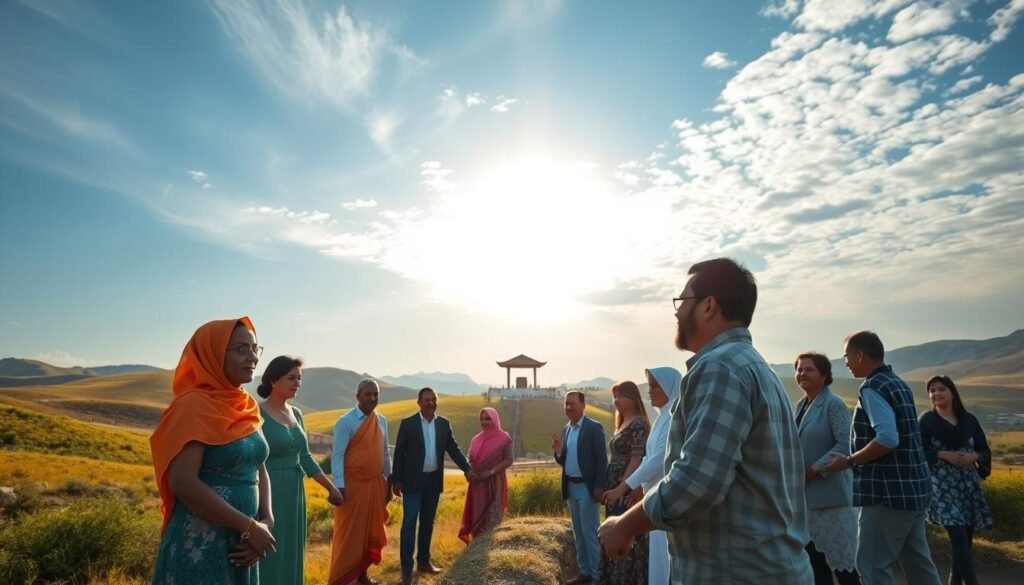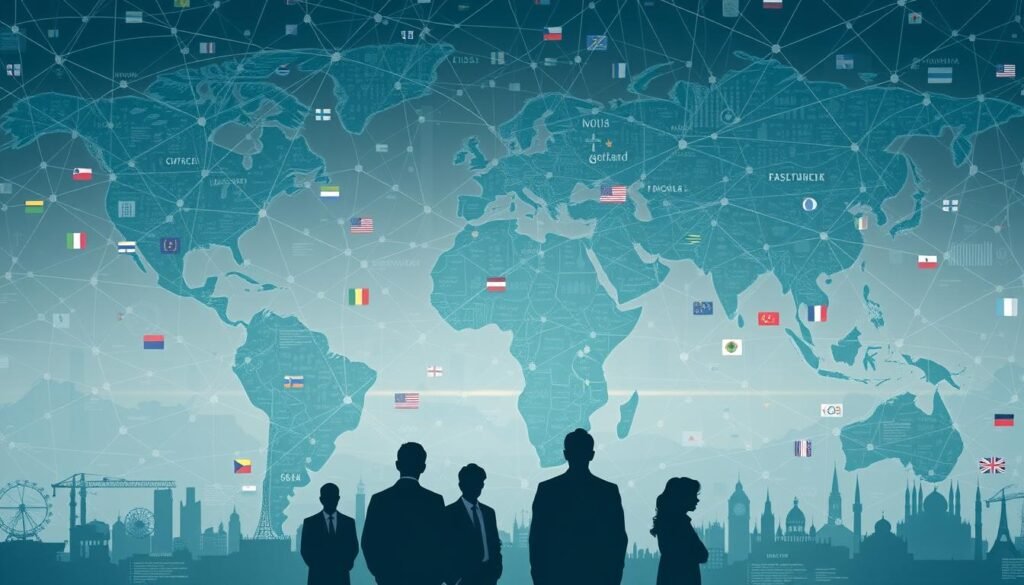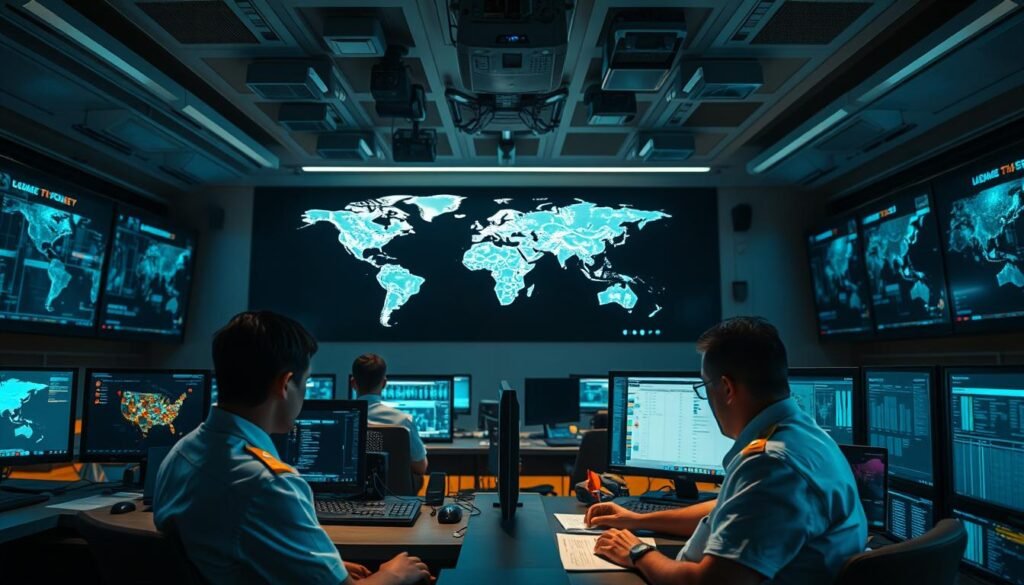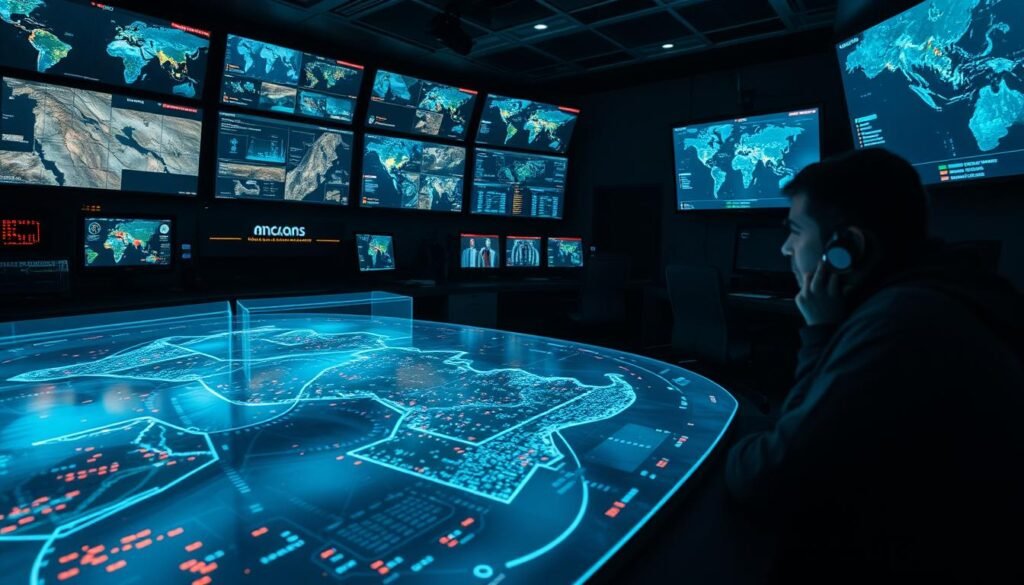Conflict and Security: Strategies for a Secure Future
Did you know that over 80 million people are displaced every year, according to the United Nations? This number highlights the pressing need for conflict and security in our world.
New threats emerge from artificial intelligence, climate change, and non-state actors. To move forward, we need to work together. This means governments, communities, and innovators must join forces.
Key Takeaways
- We see urgent needs driven by the global scale of modern conflicts.
- AI and changing climates reshape our view of threats.
- Collaborative solutions help us manage complex security puzzles.
- Preventive measures can reduce tension in fragile regions.
- Inclusive planning helps us ensure a safer future for all.
Our Case Study Approach to Conflict Resolution
We learn from real-world examples to understand how disputes start and grow. We look at economic growth, inclusive diplomacy, and strong community ties to find solutions. We study each area’s unique social and political setup, based on field research.
Background and Scope
We examine how governance, poverty, and social norms can lead to conflict. Our team talks to people from all walks of life, including women and those often overlooked. We believe their stories are key to making real changes.
Significance for Peacebuilding
We focus on acting early and setting up flexible mediation systems. Working with local groups and regional partners builds trust. This approach helps us prevent crises and work towards lasting peace globally.
Why Conflict and Security Remain Intertwined

Competition for resources and climate change-driven migration can start tensions worldwide. One nation’s security issues often affect others, putting communities at risk. This limits trust among global powers.
We think stable relationships need clear goals that ensure everyone’s safety. Our goal is to bridge differences that lead to conflict. We aim to create frameworks that support peacebuilding.
Many nations focus on protecting their borders. Yet, overlooked issues can cause unrest. This unrest affects global markets and diplomatic ties.
Links Between National Security and Peace
Our work benefits from seeing how strong defence policies meet humanitarian goals. United strategies can lower threats while keeping human dignity. We aim for solutions that protect people’s lives.
Addressing International Security Concerns
We focus on international bodies tackling cyber threats, piracy, and arms proliferation. Our goal is to promote open negotiation. This helps prevent tensions from getting worse.
Together, we can create stability where conflict seemed likely. Combined action is key to preventing conflict.
Exploring the Evolving Nature of Warfare
Warfare is changing, moving beyond old battlefields. AI, autonomous systems, and cyber tactics are making the battlefield bigger. We must think ahead about future threats.
We need to focus on digital defenses and data safety. We also need specialized teams ready to respond.
Climate change and resource scarcity are creating new challenges. We must adapt to these changes. Our approach includes:
- Reinforcing critical infrastructure
- Setting standards for responsible technology
- Fostering global partnerships
These steps help us tackle challenges that span regions and virtual spaces. We believe in innovation and working together to strengthen our national security. Our goal is to create stable environments at home and abroad.
We use the latest research, strategic talks, and planning to face modern warfare’s complexities.
The Weaponization of Interdependence

Connected economies can become strategic pressure points. Our modern supply chains, like in energy and tech, shape alliances and power balances. This raises big concerns about international security.
Economic Leverage in Global Conflicts
A sudden embargo or export shutdown can disrupt markets. Governments and companies use trade policies and resource controls to gain an edge. They also control access to technology for strategic benefits.
Implications for International Relations
These tactics can affect diplomatic ties. Unresolved trade disputes can change global partnerships. Our national interests depend on stable resources, making international security more important.
Potential Avenues for Conflict Management
We support strong rules for fair negotiations. Economic safeguards and legal frameworks are key to reducing risks. Working together on shared resources can lead to stable agreements that protect global stability.
The Role of the New European Security Architecture
Europe is changing how it defends itself. We’re moving towards a future where sharing intelligence and early warnings are key to peace. The EU and NATO are working together better, focusing on quick responses and united military strength.
Historic Shifts in Security Studies
Studying old security ideas helps shape today’s policies. Experts have shown how diplomatic relationships have grown, highlighting new dangers and the need for more watchfulness in Europe.
Bridging Gaps in Cooperation
States are working to close cultural, political, and logistical gaps. They’re using shared decision-making to strengthen their defenses and achieve common goals. This teamwork is raising the standard for making a real difference in preventing conflicts.
Analyzing the Red Sea and Global Maritime Security
The Red Sea is a key route for global shipping. It connects major economic areas with important trade paths. These paths are vital for transporting energy. We focus on how climate and territory affect maritime trends here.
Disputes over fishing and strategic ports can cause tension. Naval cooperation is essential for keeping peace and security. Joint patrols help protect trade and prevent threats like piracy and smuggling.
- Maritime routes demand constant vigilance
- Energy shipments require strong legal frameworks
- Shared efforts can address coastal instability
We think regional challenges need a strong response. This includes diplomacy and defense. Global partnerships help keep shipping lanes open, even with new challenges. Our efforts support stability in maritime areas.
| Challenge | Impact | Solution |
|---|---|---|
| Border Disputes | Heightened regional tension | Diplomatic negotiations |
| Piracy & Crime | Threats to trade and crew safety | Joint naval patrols |
| Environmental Risks | Coastal degradation | Conservation measures |
Preventing Escalation Through Effective Conflict Management

We start managing conflicts early to avoid them getting worse. We use local solutions, third-party help, and include everyone in politics. This way, we encourage talking and reduce violence.
Early warning systems and secret talks are key to spotting trouble. They help us talk openly with important people. We make sure women, youth, and others are heard. Their ideas help find peaceful ways to solve problems.
Investing in people’s lives is also important. Trade and development help reduce disagreements. By using negotiation and stability efforts together, we can stop conflicts before they start.
| Conflict Management Tool | Key Benefit |
|---|---|
| Local Dialogue Initiatives | Build mutual trust at the grassroots level |
| Third-Party Mediation | Offer neutral guidance for disputing groups |
| Inclusive Political Processes | Empower underrepresented voices in decision-making |
Case Study: Peace and Security Strategies in Action
We learn a lot from real-life problems that affect global peace. We use diplomacy, defense, and economic plans to solve these issues. These steps help us find positive solutions in unstable areas.
Developing Comprehensive Conflict Prevention Plans
We start by finding out what causes trouble in local areas. Issues like weak governments, lack of resources, or social exclusion often lead to violence. We work with groups like the United Nations to spot these problems early.
We collect data carefully to act quickly. We also make sure governments are open with their plans. This way, we can manage conflicts better.
Implementing National Security Initiatives
We connect our plans to bigger security ideas. We support women’s roles in peace efforts and team up with the police. Military help and talking to the public also help lower tensions.
Leaders from all sides work together to make things safer. This teamwork helps us achieve lasting peace.
Deep Dive: Security Analysis in Unstable Regions

We keep a close eye on any sign of long-term unrest. Spotting these signs early is critical in our security analysis. Our leaders need constant updates that show both current data and detailed reports.
Identifying Key Risk Indicators
We search for early warning signs of conflict. These include public protests, sudden political disagreements, and growing distrust among people. These signs help us focus our efforts. We track these risks closely to act before they become big problems.
Building Sustainable Peacebuilding Frameworks
We support frameworks that mix humanitarian aid, new infrastructure, and fair policies. These elements help communities heal and build trust. Our strategy includes open talks, local projects, and help from global organizations. This way, we build stronger connections that help avoid more trouble.
| Key Risk Indicator | Proactive Measure |
|---|---|
| Election Tensions | Transparent Monitoring and Mediation |
| Human Rights Abuses | Swift Investigations and Legal Accountability |
| Extremist Narratives | Counter-Messaging and Community Engagement |
Partnering for Long-Term Peace and Security
We know that strong partnerships are key to lasting stability. Working together, military, diplomatic, and development groups tackle fast-changing threats. This teamwork helps us prevent crises and protect communities, leading to peace worldwide.
Our response must keep up with the changing face of war. We share resources and work together better to spot dangers early. Our experience helps us fight cyber threats and other new risks that affect global peace.
Building alliances that cross cultural and political lines is important. Working with international groups and local leaders helps us tackle big challenges together. This teamwork builds trust, improves communication, and leads to lasting results.
We grow these partnerships through training, research, and crisis plans. Our aim is to secure a safer future for today and tomorrow’s generations.
Overcoming Obstacles to Conflict Prevention
We know that different national interests, not enough money, and a lack of political will can stop efforts to prevent violence. We need to keep working together and make sure tensions don’t rise. Our goal is to take action as a group and understand what might get in the way.
Addressing Diplomatic Hurdles
States sometimes lose trust in talking things out when faith in negotiations fades. Some powers might use supply chain ties to their advantage, making it harder to talk. This can lead to more fighting. We think that open and honest talks can help rebuild trust and fix differences.
Coordinating International Efforts
We think that working together well can overcome obstacles. It’s important to have common goals, but the use of interdependence as a weapon can test our unity. By working together and sharing resources, we can act quickly. Our goal is to build strong alliances worldwide to prevent conflicts.
| Diplomatic Tool | Potential Gain | Key Challenge |
|---|---|---|
| Early-Warning Systems | Reduces surprise attacks | Requires timely intelligence |
| Multilateral Summits | Increases policy alignment | Demands broad consensus |
| Conflict-Sensitive Funding | Promotes local peace efforts | Faces budgetary constraints |
Assessing the Outcomes of Our Conflict and Security Case Study
We looked at different scenarios to find out what works for lasting peace. Our study shows that working together locally and internationally is key. The EU’s Common Security and Defense Policy is a great example of how to tackle changing threats.
Lessons Learned and Best Practices
Peace often comes from strong partnerships and adaptable alliances. The new European security plan helps by making defense strategies more effective. Adding gender-sensitive policies and clear communication builds trust, leading to stable growth.
These steps help prevent violence and mend broken communities. They are essential for a strong, peaceful future.
Identifying Paths for Future Research
We think studying hybrid warfare, climate risks, and economic issues could lead to new security strategies. Our research shows that using the new European security plan in peace efforts could speed up progress. We aim to share these findings globally and tailor them to local needs.
Conclusion
We’ve seen how important global cooperation is for keeping people and economies safe. Maritime security shows us that problems in one place can affect the whole world. This can cause big trade problems and hard times for many.
Looking into the Red Sea and global maritime security, we see how key it is to protect shipping routes. By tackling conflicts early, we help communities stay stable and keep vital resources safe.
We support a mix of strong diplomacy and modern peacebuilding. This mix makes countries more resilient, which is key for those depending on sea routes.
We’re dedicated to studying security trends and pushing for open talks among leaders. We think working together more in defense can lower the costs and risks of future fights.
We encourage everyone to keep working on solutions that build trust and stop conflicts. The Red Sea and global maritime security are key for safe trade and well-being for all. Together, we can create a safer future based on real cooperation.




